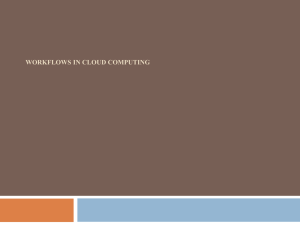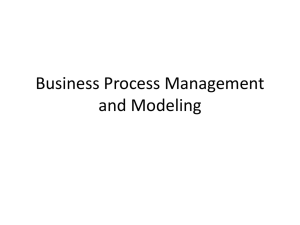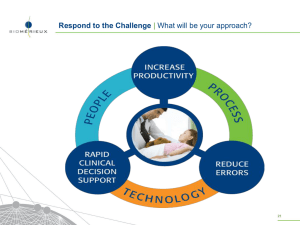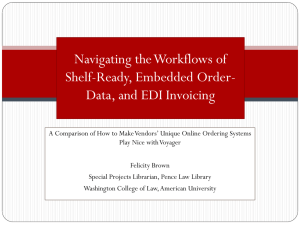Processing of a CAD/CAE Jobs in grid environment using Elmer
advertisement
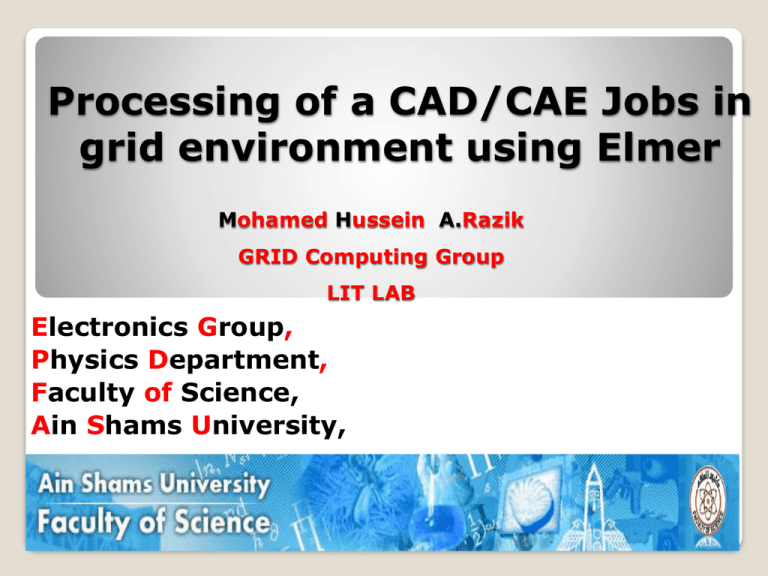
Processing of a CAD/CAE Jobs in grid environment using Elmer Mohamed Hussein A.Razik GRID Computing Group LIT LAB Electronics Group, Physics Department, Faculty of Science, Ain Shams University, Aim of the Task The aim of my task is to simulate a physical phenomena which is heat transfer by using Elmer software and execute this simulation on the grid and take the result from the grid to the PC via user interface. What is Elmer? Elmer is a finite element software package for the solution of partial differential equation(s),dealing with multiphysical simulations. The Elmer package contains solvers for a variety of mathematical models. The following list summarizes the capabilities of Elmer in specialized fields. Physical models in Elmer • Heat transfer: models for conduction, radiation and phase • • • • • • • • change Fluid flow: the Navier-Stokes, Stokes and Reynolds equations, k-" model Species transport: generic convection-diffusion equation Elasticity: general elasticity equations, dimensionally reduced models for plates and shells Acoustics: the Helmholtz equation Electromagnetism: electrostatics, magnetostatics, induction Micro fluidics: slip conditions, the Poisson-Boltzmann equation Level set method: Euleri an free boundary problems Quantum Mechanics: density functional theory (Kohn-Sham) Numerical methods in Elmer For approximation and linear system solution Elmer offers a great number of possibilities. The following list summarizes some of the most essential ones. • All basic element shapes in 1D, 2D and 3D with the Lagrange shape functions of degree k 2 • Higher degree approximation using p-elements • Time integration schemes for the first and second order equations • Solution methods for Eigen value problems • Direct linear system solvers (Lapack & Umfpack) • Iterative Krylov subspace solvers for linear systems • ILU preconditioning of linear systems • Parallelization of iterative methods • The discontinuous Galerk in method • Stabilized finite element formulations, including the methods of residual free bubbles and SUPG • Adaptively, particularly in 2D Introduction to Message Passing Interface (MPI) What is MPI? ◦ Message Passing Interface Message passing is a method by which data from one processor memory is copied to another processor memory Why MPI? ◦ MPI library functions enable programmers to write portable codes, which can run on distributed-memory/shared memory multiprocessor machines cluster of workstations 9 Parallel processing Parallel processing is the ability to carry out multiple operations or tasks simultaneously. Parallel Processing in Computers The simultaneous use of more than one CPU or processor core to execute a program or multiple computational threads. Ideally, parallel processing makes programs run faster because there are more engines (CPUs or cores) running it. Parallel Implementation in Elmer The general concept of a parallel run within Elmer is displayed in Figure . Elmer uses domain decomposition for distributing the load to multiple processes that are being run on either different cores or CPUs. To that end, the initial mesh has to be split into parts that – with respect to the applied models – lead to similar loads of the processors. Practice on Elmer software The aim task is to run a simulation experiment on the grid and this simulation is worked parallel and take the result and store it on the pc via user interface. We have a physical problem heat transfer begins with certain boundary conditions after certain time we study the heat transfer. Workflow to create Elmer file Open your input file (example: samples/grd/angle3d.grd): Workflow Optionally configure mesh generator and remesh: Workflow The values in the config dialog are inherited from cmd line tools: As shown in special window Workflow Remeshing is perfomed in a separate thread: Workflow Manipulate boundaries: Select boundaries by holding down the CTRL-key while double clicking. Choose ”unify surface” to join: Workflow Define an equation (PDE-system) to solve: As shown in special window Workflow Let us define the ”heat equation” as an example: As shown in special window Workflow Similarly, we can next define material properties and parameters: As shown in special window Workflow Add body force: Workflow set boundary conditions: Workflow Generate solver input file (sif): Workflow Save the model: Workflow Run solver: Workflow Convergence monitor reveals possible problems: Job submission of Elmer file to the grid Processing of the data on the grid Job status Retrieve job's output Transfer the result from the grid to the pc via interface. Workflow Visualize the results by Elmer post: Acknowledgement I would like to thank: Alexander Ujhinskiy Nikolay kutovskiy For continuous efforts for teaching the aspects and completing the jobs of the grid. Thanks for sincerely help. AND Thanks for supervisors of the school for help and attentions. Prof.Dr.Ali Ellithi & Prof.Dr. Ali Khalil Thank you for your attention Workflow Edit the solver input file (if needed): Workflow Turn on/off boundary index numbering for verification: Workflow Data is given in the ”General” and ”Heat equation” tabs:


